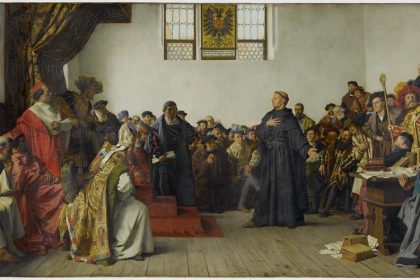The season of Lent is a time of spiritual preparation for Christian believers before Easter. In the first centuries of Christianity, Easter was celebrated at the same time as the Jewish feast of Passover, so the traditional Jewish symbolism of the Lamb that was slain was enriched by the narrative of the death, suffering and resurrection of Jesus Christ as the Lamb of God. Also, the symbolism of preparation for Passover was adopted in the life of the church and the liturgy in the season of Lent came out of Hebrew tradition.
Since the time of the Exodus from Egypt, the Israelites were commanded to “cleanse their whole houses” before the feast (Ex.12). This meant that at this time every year the houses of the Israelites were to be cleansed of all yeast, leaven. In reality, the Hebrew word חמץ (chametz) means leaven, rot, and mildew. This command continues to be followed by religious Jews to this day.
Such a command also had a practical application. In early springtime the old wheat stores were running low and becoming mouldy, the “housecleaning” proved to be an ideal opportunity to also clean the stores of the old, already mouldy wheat and prepare them for the new wheat for the first spring harvest.
This symbolism, just like the eight feast days before Passover when only unleavened bread was eaten, was intended to be a reminder to the people of God as to who they really were:
„A people holy to the LORD…chosen out of all the peoples on the face of the earth to be his people, his treasured possession.
DEUT. 7:6
The “leaven” spoken of here refers to discernment and is a symbol for separation. The believers had to abstain from all evil, so they could be clean, without blemish from the leaven of the idolatrous and pagan world, which surrounded them.
In the New Testament, the symbolism of leaven became even more laden with meaning. Jesus thus warned His disciples that they should beware of the leaven of the Pharisees and Sadducees! (Mat 16:6). By this he was bringing attention to the teaching of the scribes and theologians of his time, who through sophisticated methods tried to circumvent the commandments of God -especially the demands for justice and moral and ethics code of God‘s Law.
Jesus was, therefore, harsher against them than on those outwardly considered as much greater sinners.
The Apostle Paul also wrote in his letter to the church in Corinth an explanation of the symbolism of yeast, Passover and the lamb :
….Don’t you know that a little yeast leavens the whole batch of dough?
Get rid of the old yeast, so that you may be a new unleavened batch—as you really are. For Christ, our Passover lamb has been sacrificed. Therefore let us keep the Festival, not with the old bread leavened with malice and wickedness, but with the bread of unleavened sincerity and truth…
(1 Cor 5:6-8)
With these sentences written just a few chapters before the famous love chapter, the Apostle warns of the leaven of sin and wickedness among the first Christians. Very concrete things were underlined such as fornication, strife and idolatry.
The encouragement of St. Paul that the believers should be cleansed and separated from sin and worldly behaviour was adopted as an important doctrine and practice that has lasted throughout 2000 years of the church history despite the denomination. The contemplative time of Lent reminds the believers every year of the need for cleansing in the believer‘s life from evil ways and preparing our minds to meet the resurrected Saviour.
That kind of preparation and decision making is relevant more than ever for today‘s Christians. More and more often we are confronted with the pressure of the contemporary culture to adopt the „old leaven“. Today the leaven is wrapped in sugar-coated mottos like ‘‘tolerance and inclusion“ – something that makes the church permissible, and open for unbiblical practices.
For many years, this (un)spiritual and worldly leaven is present in the world of Methodism (particularly in the UMC) and seriously threatens to pollute the whole dough.
Responsible leaders have recognized the momentum that is now building and have acknowledged that remaining any longer in such a denomination would just prolong the agony and quicken the decay of the church. For this reason, it was a brave and good decision to separate from the UMC and launch a new denomination, which will have the vision to embrace ‘‘unleavened sincerity and truth“.
Will you join us?
Source: wesleyancovenant.eu



